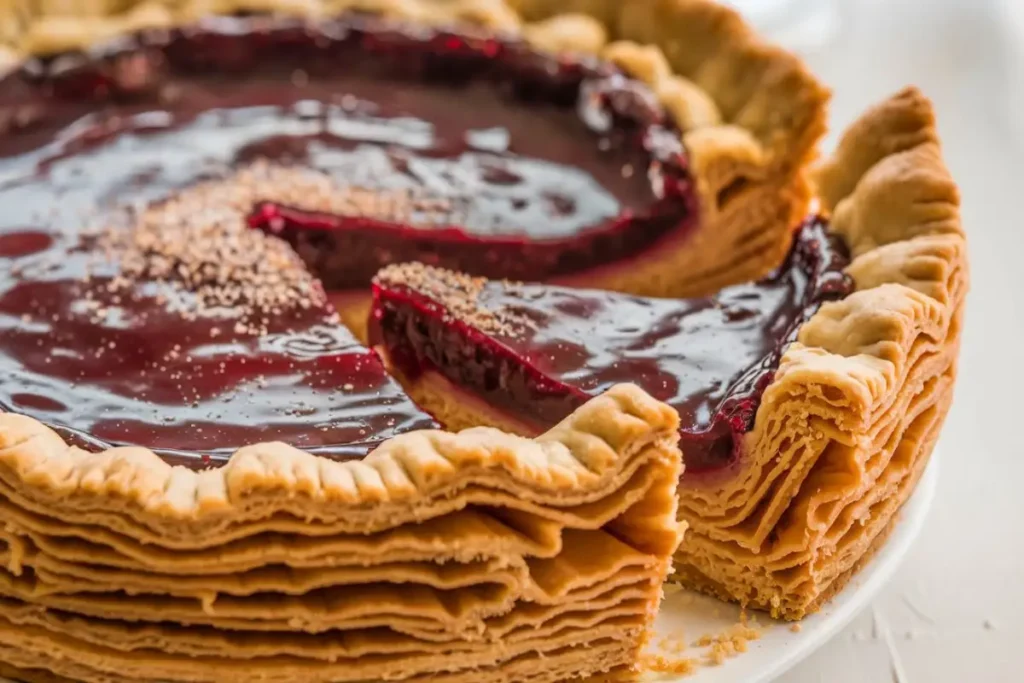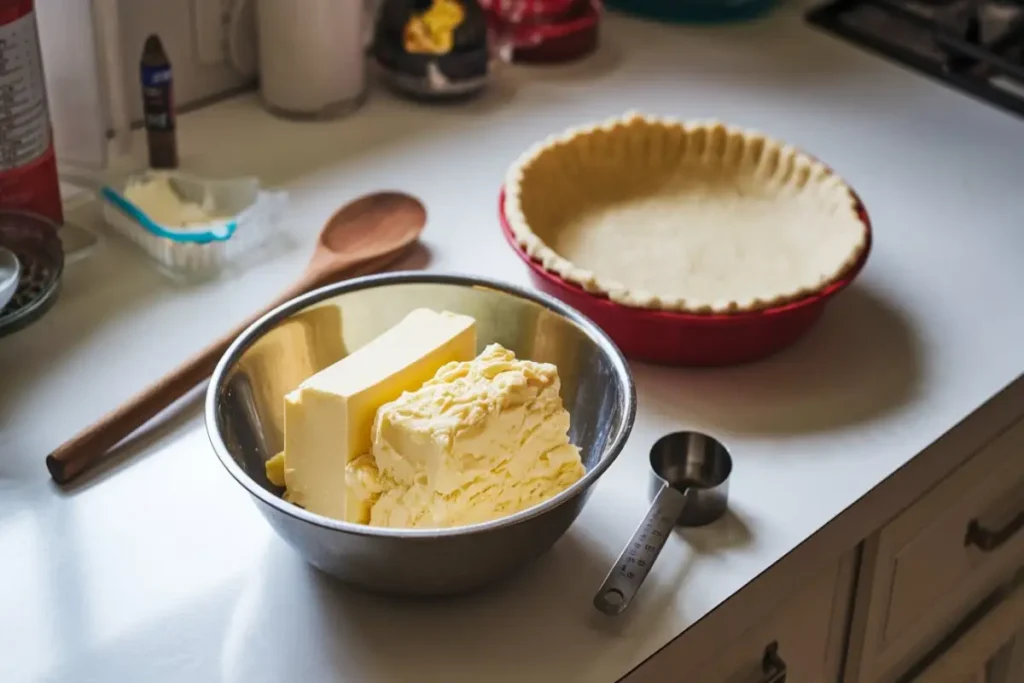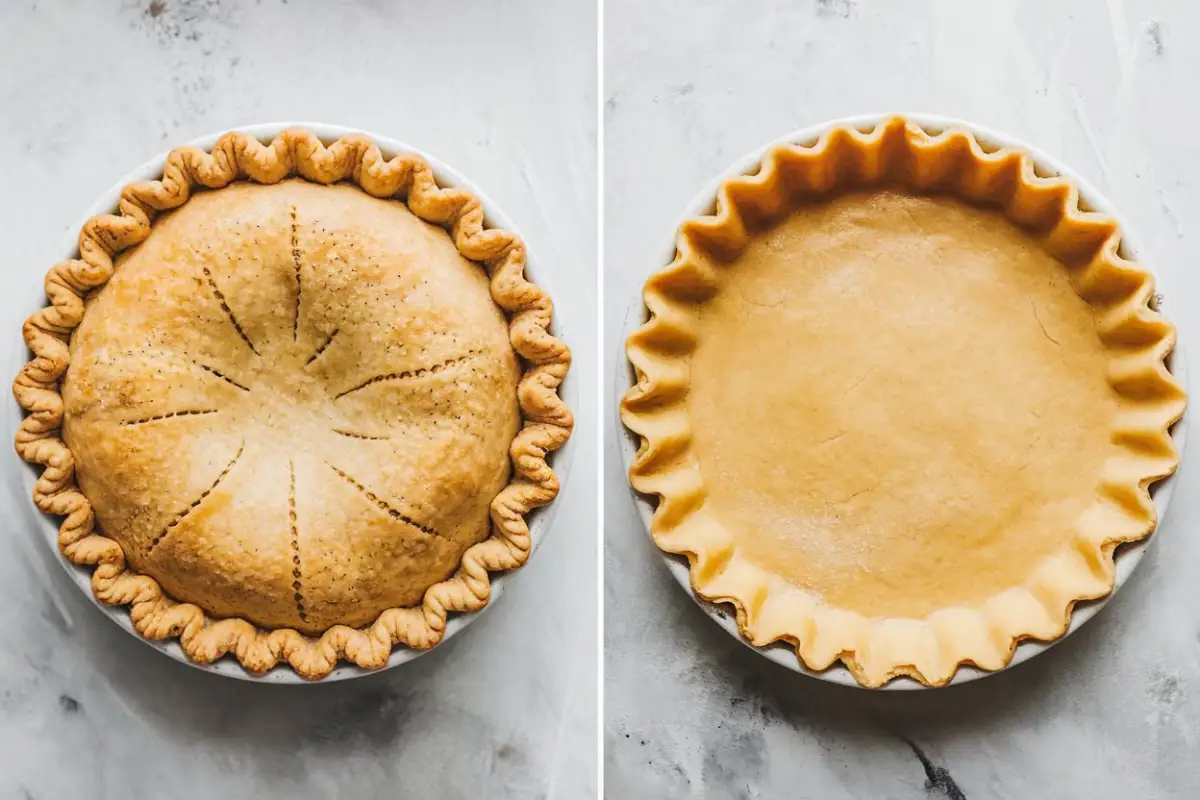Butter vs. Crisco which makes the best pie crust? This age-old debate has divided bakers for generations. Some swear by butter for its rich flavor, while others argue that Crisco provides superior flakiness. If you’ve ever struggled with this decision, you’re not alone. In this guide, we’ll break down the science, benefits, and quirks of both fats so you can make the best choice for your next baking masterpiece.
Introduction: The Pie Crust Debate
Have you ever had a pie that was almost perfect if only the crust had been flakier or tasted better? Pie crust is like the unsung hero of baking. It doesn’t get the same attention as the filling, but let’s face it, a bad crust can ruin the whole dessert. So, what makes the perfect pie crust? The answer lies in the fat you use. Whether you’re team butter or team Crisco, both fats bring something unique to the table. But which one is better? Let’s break it down.
Why Pie Crust Matters: The Foundation of a Great Pie

Think of pie crust as the stage on which the filling performs. Even the most decadent chocolate or the juiciest fruit filling won’t shine if the crust isn’t up to par. A good crust should be:
- Flaky: Layers that melt in your mouth.
- Flavorful: Complementing the filling without overpowering it.
- Structured: Strong enough to hold the filling but tender enough to cut through easily.
Getting all these elements right can feel like balancing on a tightrope, and the choice of fat plays a starring role in this performance.
What Makes a Good Pie Crust?
Okay, so we know crust is important. But what exactly makes it “good”? It’s all about the trifecta: texture, taste, and workability. Let’s dive into each aspect.
Key Characteristics of the Perfect Pie Crust
- Texture: Flakiness is the holy grail. It’s that satisfying crunch when you bite in, followed by a buttery crumble. This texture comes from how the fat interacts with the flour.
- Taste: While the filling carries the main flavor, the crust should enhance it. A bland crust? No thanks!
- Workability: Ever tried rolling out a dough that cracks and falls apart? Nightmare. The right fat can make the dough pliable and easy to handle.
Flavor, Flakiness, and Structure: A Balancing Act
Here’s where it gets tricky. Butter vs. Crisco both excel in some areas and fall short in others. Butter, for example, has unbeatable flavor but can be a challenge to work with. Crisco, on the other hand, delivers a reliable flaky structure but doesn’t pack the same punch in taste. It’s like choosing between a luxury sports car and a dependable SUV each has its own merits.
Butter vs. Crisco: The Ultimate Pie Crust Comparison
So, let’s get to the heart of the matter. What makes butter and Crisco so different when it comes to pie crusts?
Understanding Butter: Texture, Taste, and Benefits
Butter is the darling of traditional bakers, and for good reason. It’s natural, flavorful, and easy to find. Here’s what makes butter stand out:
- Rich Flavor: Butter brings a deep, creamy taste that enhances sweet and savory pies alike.
- Flaky Layers: When butter melts in the oven, it creates steam pockets that lead to those coveted flaky layers.
- Natural Ingredients: It’s simple just cream churned into a solid.
However, butter isn’t without its challenges. It can be tricky to work with because it softens quickly, especially in warm kitchens. Ever had your dough turn into a sticky mess? Yep, butter might be the culprit.
Crisco in Pie Crusts: Flakiness and Easy Workability
Crisco (or shortening) is a bit of a wildcard. While it’s not as romanticized as butter, it has some undeniable perks:
- Reliable Flakiness: Shortening has a higher melting point, so it stays solid longer during the baking process. This leads to super flaky crusts.
- Workable Dough: It’s more forgiving than butter, making it ideal for beginners.
- Neutral Flavor: While it lacks butter’s richness, this can be a good thing if you don’t want the crust to overshadow the filling.
That said, Crisco isn’t perfect. It’s a processed fat, which might not appeal to purists. Plus, it doesn’t offer the same depth of flavor as butter.
Why Pie Crust Matters: Setting the Stage for Perfection
A pie crust is like the stage on which your filling performs. Whether it’s a savory chicken pot pie or a sweet fruit cobbler, the crust is essential. To achieve the perfect crust, consider three key factors: flakiness, flavor, and structure
Common Problems with Pie Crusts and Their Solutions
Pie crust may seem simple just fat, flour, water, and maybe a pinch of salt but let’s be real: it’s a delicate dance. One wrong move, and your crust can go from flaky perfection to a soggy, tough, or crumbly mess. Don’t worry, though! With a little know-how, you can tackle these common pie crust problems and come out on top every time.
Is Pie Crust Better with Butter or Crisco? Comparing Fats for the Best Pie Crust
The Butter vs. Crisco Debate: Which Fat Makes the Perfect Pie Crust?
Pie crust is a delicate balance of flavor, flakiness, and structure. Choosing between butter and Crisco can make or break your pie. Let’s compare their unique qualities to help you decide which one reigns supreme in crafting the ultimate crust.
Why Butter vs. Crisco Matters for Pie Crust Success
A pie crust’s quality directly affects the taste and texture of the finished pie. Whether you’re making a sweet fruit pie or a savory quiche, the choice of butter vs. Crisco determines how flaky, flavorful, and workable the dough is.
Butter in Pie Crusts: Rich Flavor and Flaky Texture
Butter is prized for its natural, rich flavor and its ability to create golden, flaky layers. However, it requires precision to handle correctly.
Crisco in Pie Crusts: Flakiness and Easy Workability
Crisco (shortening) is loved for producing flaky pie crusts that are easy to handle, making it ideal for beginners or intricate pie designs.
Butter vs. Crisco Pie Crust: Can You Have the Best of Both?

Combining butter and Crisco creates a crust with the rich flavor of butter and the reliable flakiness of Crisco. Use a 60/40 ratio of butter to Crisco for a balanced crust.
Common Pie Crust Problems: How Butter and Crisco Affect Texture and Flavor
- Dry and Crumbly Crusts: Butter may require careful moisture control, while Crisco offers more forgiveness.
- Soggy Bottoms: Butter adds flavor but may need blind baking, whereas Crisco ensures a more uniform bake.
Problem: Dry and Crumbly Dough
You start rolling out your dough, and it falls apart like a house of cards. Sound familiar? This happens when there isn’t enough moisture or the fat hasn’t been properly incorporated.
Solution:
- Add cold water, one tablespoon at a time, until the dough just comes together. Avoid overmixing, as that can make the crust tough.
- Pro tip: Use a pastry cutter or your fingertips to blend the fat and flour evenly. The goal is to achieve a crumbly, sand-like texture before adding water.
Problem: Dough Shrinking in the Oven
You roll out a beautiful crust, line your pie dish, and pop it into the oven only to watch the edges shrink into a sad little pancake. What gives?
Solution:
- Rest the dough in the fridge for at least 30 minutes after rolling it out. This relaxes the gluten, which is responsible for the shrinkage.
- Avoid overworking the dough during mixing and rolling. The more you handle it, the more the gluten develops, leading to elasticity (aka shrinkage).
Problem: Soggy Bottoms
Nobody likes a soggy bottom (well, at least not in pies!). If the filling soaks into the crust, it can ruin that delightful textural contrast.
Solution:
- Blind bake the crust: Line the crust with parchment paper, fill it with pie weights or beans, and bake it before adding the filling. This creates a barrier that prevents sogginess.
- Brush the crust with an egg wash or melted butter before baking to seal it.
Problem: Crust Too Tough
If your crust is more like cardboard than a buttery dream, the likely culprit is overmixing or adding too much water.
Solution:
- Handle the dough as little as possible. Remember, less is more!
- Use cold ingredients, including butter, Crisco, and water. Warm fat can bind with the flour too much, leading to a dense texture.
Butter vs. Crisco for Pie Crust: Pros and Cons
Why choose between Butter vs. Crisco when you can have both? Many bakers swear by a hybrid approach, blending the best of both worlds. The idea is simple: use butter for flavor and Crisco for flakiness. Let’s break it down.
The Science of Mixing Fats: Getting the Best of Both Worlds
When you mix butter and Crisco, you’re essentially creating a dream team:
- Butter gives you that unbeatable flavor and richness.
- Crisco contributes stability and flakiness, making the dough easier to handle.
Here’s how it works:
- Use a ratio of about 60% butter and 40% Crisco. This balance ensures you get buttery taste without sacrificing structure.
- Cut both fats into the flour separately, keeping them cold to avoid over-incorporation.
Recipes That Shine with a Butter vs. Crisco Blend
- Fruit Pies: The buttery flavor complements sweet fillings like apple, cherry, or blueberry, while Crisco ensures a crust that holds up to juicy fruit.
- Savory Pies: Quiches and pot pies benefit from the neutral flakiness of Crisco, with just enough butter to add depth.
- Lattice Crusts: The Crisco makes the dough easier to roll and braid, while the butter adds a golden-brown sheen during baking.
Health Considerations: Butter vs. Crisco
Butter: A natural option with vitamins but higher in saturated fats.
Crisco: Lower in saturated fats but processed and sometimes includes trans fats.
For a healthier alternative, consider coconut oil or Greek yogurt.
Nutritional Content Comparison
- Butter: A natural fat that contains vitamins like A and D but also has saturated fat. Moderation is key!
- Crisco: A processed fat that’s typically lower in saturated fat but higher in trans fats (although many modern versions are trans-fat-free).
While neither option is particularly “healthy,” butter is considered the more natural choice, while Crisco is a reliable alternative for those avoiding dairy.
Healthier Alternatives to Traditional Fats
If you want to lighten things up, here are some options:
- Coconut Oil: Adds a subtle sweetness and creates a tender crust.
- Greek Yogurt: Swap part of the fat for Greek yogurt for a healthier twist.
- Avocado Oil: A great option for those avoiding saturated fats entirely.
Expert Tips for Perfecting Your Pie Crust
Making a pie crust that looks and tastes like it came out of a bakery doesn’t have to feel like rocket science. With a few expert tips, you’ll be rolling out dough like a pro in no time. Ready to level up your pie game? Let’s go!
Choosing the Right Flour and Ingredients
When it comes to pie crusts, not all flours are created equal. The type of flour you use can make or break your dough.
- All-Purpose Flour: The go-to choice for most bakers. It provides a good balance of structure and tenderness.
- Pastry Flour: If you want an even more tender crust, pastry flour is your friend, thanks to its lower protein content.
- Keep It Simple: Use unsalted butter or Crisco to control the salt level, and always go for ice-cold water—it prevents the fat from melting too quickly.
Techniques for Mixing, Rolling, and Shaping the Dough
The process of working with pie dough is where the magic happens. Here are the key steps:
- Keep It Cold: Cold ingredients are essential. If your butter or Crisco starts melting while you’re mixing, pop the dough into the fridge for a few minutes.
- Don’t Overwork It: Think gentle and quick mix the dough just until it holds together. Overworking activates the gluten, making your crust tough.
- Roll It Right: Roll from the center outwards, turning the dough a quarter turn after each roll to maintain a circular shape.
- Use Parchment Paper: Rolling dough between two sheets of parchment paper can prevent sticking and make cleanup a breeze.
Blind Baking Done Right
If you’re making a pie with a custard filling or something particularly juicy, blind baking is your best friend.
- How to Do It:
- Roll out your dough, line the pie dish, and trim the edges.
- Place a sheet of parchment paper over the crust and fill it with pie weights or dried beans.
- Bake at 375°F (190°C) for 15 minutes, then remove the weights and bake for another 5-7 minutes to crisp it up.
Blind baking ensures a golden, crisp crust that won’t turn soggy when filled.
For more recipes Follow me in Facebook and Pinterest
Frequently Asked Questions (FAQs)
Can I substitute Crisco for butter in pie crust?
Yes, you can substitute Crisco for butter in pie crust, but expect a difference in both flavor and texture. Crisco creates a flakier, more stable crust, while butter gives a richer, more complex taste. For best results, try using a mix of both.
Which fat gives the flakiest pie crust?
Shortening like Crisco typically gives the flakiest crust due to its high melting point, which helps create defined layers. However, butter can also be flaky if handled correctly and kept cold throughout the process. Combining the two often produces the best flakiness and flavor.
Does butter make pie crust harder?
Not necessarily, but it can if overmixed or if the dough gets too warm. Butter-based doughs require extra care to keep cold. When done right, butter creates a tender, flavorful crust. For a more forgiving dough, Crisco or a butter-Crisco blend is a better choice.
Is butter or Crisco better for blind baking?
For blind baking, Crisco crusts hold their shape more consistently, especially in warm kitchens. Butter crusts may shrink more unless properly chilled and weighted. A butter-Crisco blend is ideal for blind baking as it combines stability with rich flavor.
Conclusion: Butter vs. Crisco What’s the Best Pie Crust?
So, which fat truly wins in the butter vs. Crisco pie crust debate? The answer depends on what you’re baking and what matters most to you.
- Choose butter for unbeatable flavor and a golden, crisp crust.
- Choose Crisco for ultra-flaky layers and a more forgiving dough.
- Choose both if you want the perfect balance of flavor, flakiness, and structure.
Pie crust isn’t just a base it’s half the experience. With the right fat (or combo), your pies won’t just taste better they’ll be better.

